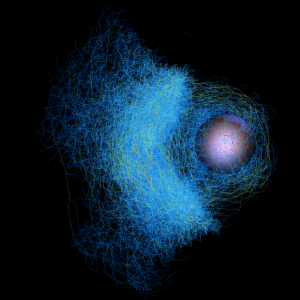In Silico Reconstitution of Actin-Based Motility
Links
- The paper published in PLoS Biology.
- High resolution movies of most of the simulations mentioned in the paper.
- The CometWiki, including links to the code and instructions on how to install and run the program.
- Video tutorials:
Media Coverage:
- Nature features the paper in their research highlights section
- Biomedical Computation Review has detailed coverage
- PLoS has a research synopsis
- TheNakedSingularity(translation) also covers the project
- Highmagblog features our images
- The official PLoS Blog uses one of the images for their banner :)
Background: Cell Movement
Cells in our body use actin to move. Unlike the actin-myosin interaction that produces muscle movement, this kind of movement is on a much smaller scale—the scale of individual cells—and allows, for example, neurons to migrate and wire up to the right part of the brain, and cells in our immune system to track down and engulf bacteria. To achieve this movement, cells lay down actin polymer networks that produce force.
The in vitro model system: Bead Motility
One popular way to study how our cells use actin networks to produce force and move is using a simplified system—actin-based bead motility—which recreates motility in vitro. To do this, we coat a bead with proteins that normally tell the cell to polymerize actin, then put the bead a solution similar to that inside of the cell, which causes an actin network to build around the bead. Surprisingly, even when the bead is spherically symmetric, rather than just building a symmetric shell that gets bigger and bigger, the bead moves off, on a ‘comet tail’ of actin.
The Bead-Motility Simulator
This bead motility simulator (named ‘Comet’) helps us understand how this process works, by recreating the process in silico. It’s a top-down model, based on idea that the large-scale elastic behavior of the network is the key to motility, rather than small-scale filament effects. Because it’s able, by simulating the elastic behavior alone, not only to reproduce the experimental observations, but also to make new predictions that turn out to hold in the experimental system, it shows how the elastic behavior of the actin network works to produce motility.
Reference
In Silico Reconstitution of Actin-Based Symmetry Breaking and Motility. (2009) Dayel MJ, Akin O, Landeryou M, Risca V, Mogilner A, et al. PLoS Biol 7(9):e1000201. doi:10.1371/journal.pbio.1000201 (Free open-access article)


